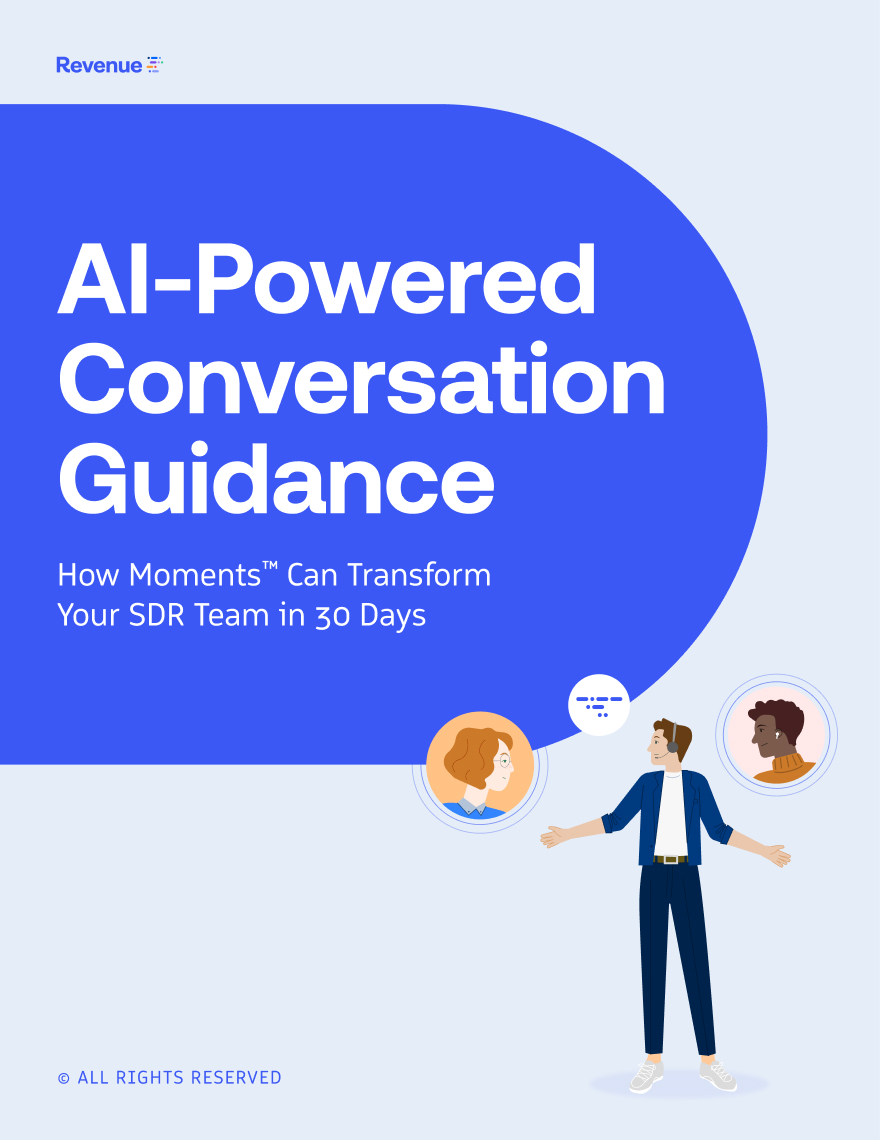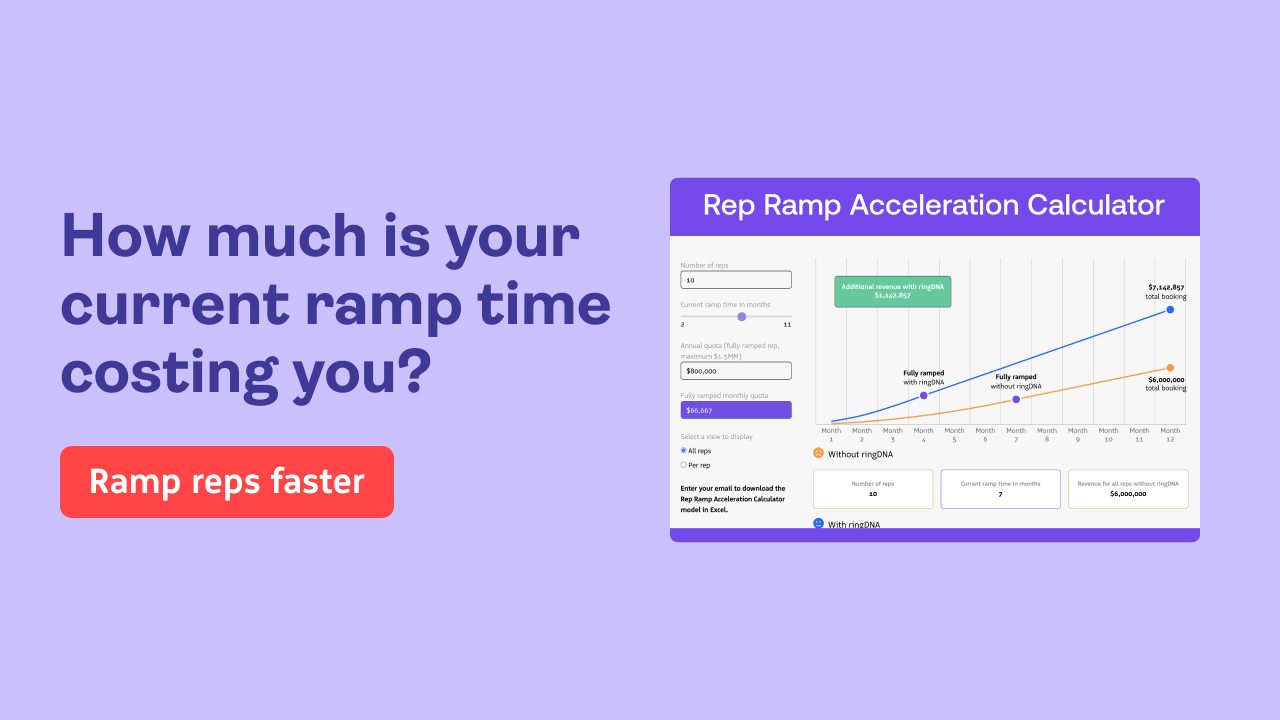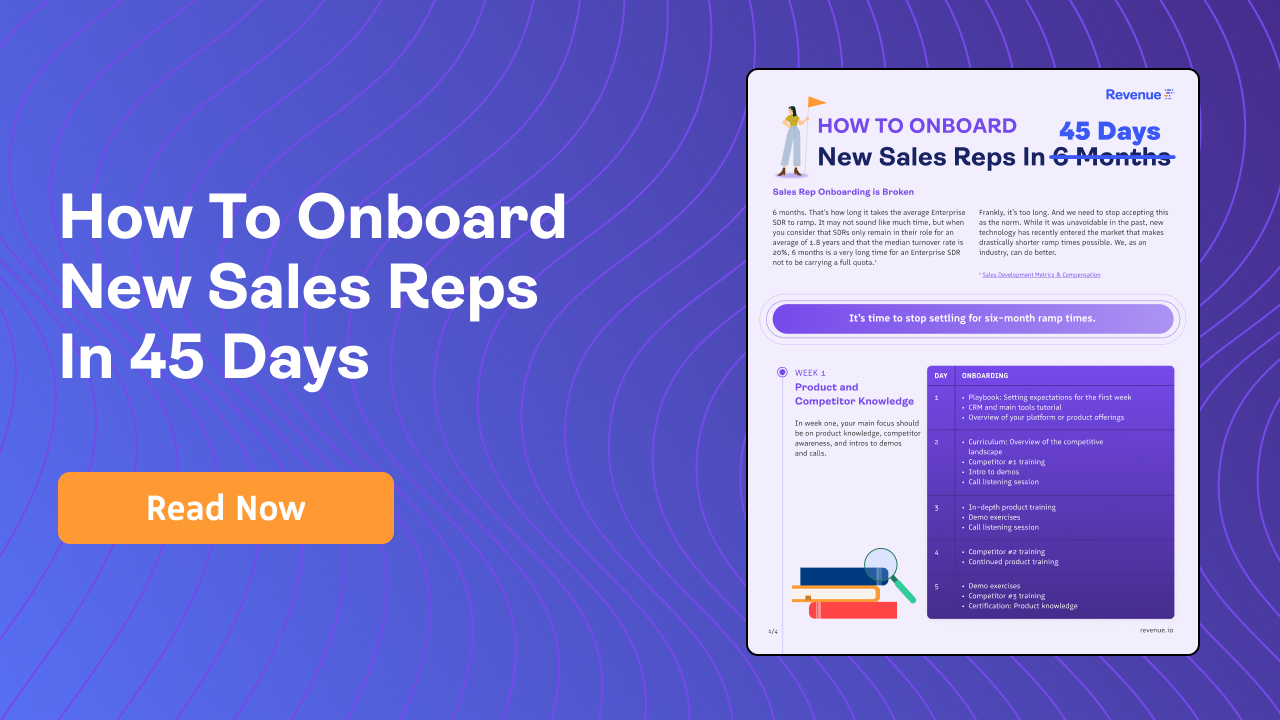Sales Ramp Time: How Long It Takes to Hit Quota (And How to Speed It Up)
Over three months. According to research by The Bridge Group, that’s the average sales ramp-up time. It may not sound like much time, but when you consider that SDRs only remain in their role for an average of 1.8 years and that the median turnover rate is 20%, 3.1 months is a very long time for an SDR not to be carrying a full quota.
Frankly, it’s too long. And we need to stop accepting this as the norm.
While it was unavoidable, new technology has recently entered the market, making drastically shorter ramp times possible. We, as an industry, can do better.
Not only do ramp times cost companies in terms of productivity and revenue, but they also put a considerable strain on Sales Managers. They’re constantly repeating themselves, trying to drill in sales lessons while also worrying about finding ways to increase pipeline and revenue. At first glance, these issues appear to be separate. However, the reality is that decreasing inside sales ramp-up time is not the only key to helping SDRs carry quotas sooner. It’s also the key to more revenue, lower churn among reps, and a better work-life balance for sales leaders.
It’s time to stop settling for three-month ramp times. The ideal ramp time is 45 days; with the right plan and technology in place, it’s more than achievable.
This post will show you how to radically decrease rep ramp time by setting up a solid onboarding plan, using the right ramping content, and leveraging powerful sales onboarding technologies.
4 Ways to Decrease Sales Ramp-Up Time with a Solid Onboarding Plan
While you likely already have a general onboarding plan for all your company’s employees, it’s important to have a specific sales onboarding plan that considers your company’s unique needs and its new reps.
Aim for Comprehension, Not Memorization
A great rep isn’t a prospecting robot. Instead, they’re a knowledgeable consultant who can provide value to prospects even before they buy your products.
Role memorization isn’t enough to do this. When building out your onboarding plan, aim for SDRs to understand your products, customers, and customers’ customers meaningfully.
Define the Sales Ramp-Up Period
Some thought leaders use the average deal size and complexity to help define the onboarding period, such as: “Onboarding period = Length of Sales Cycle + 90 Days” or “Onboarding = Length of Time to Reach 100% Quota.”
For example, if your average deal size is $2 million, the complexity of your offer may require a longer ramp period. But if you’re like most B2B companies, your ramp-up period should be set at six weeks.
Set Clear and Achievable Goals
What do you want your reps to be able to do at the end of the set ramp period? We recommend that you aim to put your SDRs on the path to mastery and give them the tools to improve continually.
They may not be sales masters by the time they finish ramping, but they’ll be able to carry a quota and improve their performance as time passes. Remember, Rome wasn’t built in a day.
Decide Where to Focus
Some elements of ramping are more important than others. Strip it down to the basics and start by focusing on buyer-centric messaging, outreach best practices, and live call execution.
3 Types of Onboarding Content You Need to Ramp Up Reps Fast
Useful content is essential when onboarding new reps. After all, reps typically forget almost 90% of their training in just 30 days if it’s not reinforced. So, you want to limit onboarding content to the most essential materials.
Three main types of content are particularly useful to have before you launch your new onboarding plan.
Playbook
This will be your reps’ roadmap for their first six weeks. Use this playbook to kick off your onboarding program, and include everything an SDR needs to do their job effectively. Document the entire SDR role, and then they’ll have the information in the playbook reinforced throughout the onboarding process.
Build a specific sequence of training exercises organized into two-hour sessions focused on key topics. Ideally, each training session should build on the last so reps finish the curriculum with a strong understanding of the basics.
To help you out, we’ve created a sample onboarding curriculum that you can download for free and adapt to your own team’s needs.
Certifications
You can use certifications to reinforce lessons, helping reps to retain more information during sales ramp up time by testing key skills. An example of a certification would be an objection handling test, or a test on the features of your products. The certifications we rely on in our onboarding plan are:
- Product knowledge
- Cold calling
- Tech stack skill
- Industry knowledge
6 Week Sales Ramp Up Plan Overview
In our own six-week ramp plan, we detail a curriculum that should be covered each week. Here is an overview of what we recommend for each week of onboarding.
Week 1: Product and Competitor Knowledge
Your main focus during week one should be product knowledge, competitor awareness, and introductions to demos and calls.
When laying out reps’ daily schedules, include other onboarding tasks that will vary based on your company, such as signing up for payroll and security or bias training. Also note that this week includes deep dives into three main competitors, which can be adjusted depending on your unique competitor landscape.
Week 2: Preparation to Make Calls
Week two ends with a cold call certification based on mastering our cold call framework, so the main purpose of this week is to prepare your reps to pass it with the practice and knowledge they’ll need to sound confident in front of prospects.
Having new reps shadow experienced reps on calls or listen to recordings from call libraries is particularly useful here. This week, there’s also an emphasis on reviewing past information (reinforcement is key!).
Sales cadence software can provide additional support once your reps are at a place where they’re calling and emailing prospects. These technologies will provide a list of tasks for reps to accomplish each day (ex, call this person; research that company), arranged and prioritized according to your rules.
Week 3: Building the Toolbox
Now that your new reps have proven they’re ready to start making cold calls, it’s time to introduce quota-carrying duties to their days. Choose a set number of calls you’d like them to make daily, and have them accomplish that along with their training.
Beyond that, this week’s emphasis is to make sure they’re confident in using all the tools they need to do their jobs — both in terms of your tech stack and prospect-facing materials created by your marketing team. When we mention “tech stack exercises,” these will vary based on what sales tools you use at your company.
Week 4: Speaking to Customers
Week four of the sales ramp-up time plan is all about how to get inside the head of the customer and be a compelling communicator over email. Whenever your reps communicate with prospects, they represent your company as a whole, so their ability to communicate well in all mediums is paramount. For reps to be knowledgeable consultants (and for them to have things to write and speak about that your prospects will relate to), they need to understand your industry beyond your products and direct competitors. The number of cold calls your reps place should also increase this week.
Week 5: The Big Picture
As of this week, your reps can do both call and email outreach. Give set numbers for calls and emails and raise the number of calls from last week. The time they’ll spend on prospecting each day will increase relative to the time they spend onboarding.
For this week, the goal is to zoom out and give your reps a better understanding of their role within the company and the career paths they have open to them as they mature as SDRs.
Week 6: Learning is a Habit
To start, raise the number of calls and emails expected for the week. Since they’re about to conclude their training, the number should be at or close to what you expect from a fully ramped SDR.
Beyond that, there are two primary goals for this week
- Reinforcing everything your reps have learned over the last five weeks
- Encouraging peer-to-peer coaching and continued learning
If you’re onboarding a group of reps, put each one in charge of recapping a specific principle for the group you went over in onboarding. If you’re only onboarding one or two, have them choose the topic they struggled with most.
Over the week, also ask each rep to become an expert on something new that you didn’t go over in onboarding. Have them present what they learned to the group in the Onboarding Graduation Ceremony.
Be sure to download your free 45-Day Sales Ramp-Up Plan for more information and a detailed weekly curriculum.
The Importance of Ongoing Training
Training should never stop after six weeks. Once your SDRs have worked through the initial onboarding plan, you can continue reinforcing previous lessons and introducing new ones with ongoing training. More experienced reps will also benefit from ongoing training, so you can and should involve the whole team in these exercises. You could even have them lead peer-to-peer training to help reps develop their leadership skills.
 Here are some ideas for what this ongoing training could focus on:
Here are some ideas for what this ongoing training could focus on:
- New product and feature release
- New marketing campaigns or content
- New competitor
- Habits of your most effective rep
- Advanced training and techniques
- Skills for career advancement
Training is most effective when reinforced in real-time. For example, Moments™ by Revenue.io uses proprietary AI-powered technology to reinforce ongoing training in real-time on calls, using nudges and notifications to help SDRs with competitor mentions, objection handling, relevant content suggestions, etc.
To find out more about real-time guidance, check our eBook “AI-Powered Conversation Guidance or check out this video:
How to Reinforce Positive Behavior with Coaching
Reinforcing good behavior and catching bad behaviors early is key in onboarding, and also in ongoing training. But the earlier you can do this in a rep’s training, the more they’ll benefit from it.
If you’re wondering which behaviors to reinforce, focus on outreach, messaging, and communication skills. These are the most important tools in a rep’s toolkit. Reinforcing these behaviors during sales ramp up time is simple:
Observe what reps are doing
Listen to call recordings, check emails, and monitor overall productivity.
Diagnose their behaviors
What are they doing that’s great? Or conversely, what could they improve on?
Prescribe Specific Actions
If you see a good behavior or habit, reward it with praise. Suggest a different action if you see a bad one and reinforce the change with reminders over the next few days.
You can review more calls and catch problematic behaviors faster if you have a dialer or revenue intelligence platform that transcribes calls. For another step up, some technologies can also notice patterns in calls with AI and flag issues for you. Conversation AI by Revenue.io offers this capability.
As an example, here at Revenue.io, there was a rep who would have very long conversations with prospects but still had trouble figuring out who should be qualified or disqualified in the sales process.
For a prospect to qualify, they had to use Salesforce since Revenue.io uses a native Salesforce integration. The rep’s manager didn’t understand what was going on until they went back through the call recordings and realized that the rep was genuinely connecting with prospects (great!) but getting so caught up in the conversation that they forgot to ask them if they used Salesforce (not so great). The solution was clear now that the manager knew what was going on.
Reinforcing Rep Behaviors
They reinforced the rep’s behavior of forging authentic connections with prospects but also set up an alert in Conversation AI (the Revenue.io conversation intelligence solution) to track all mentions of Salesforce on their calls. So the rep could track their progress and see how many calls they mentioned Salesforce daily. By the end of the first week, they were mentioning Salesforce on every single call, and easily qualifying or disqualifying every prospect. Problem solved!
How much does your current sales ramp-up time cost you? Check out our ramp-up calculator to determine how much more revenue you can drive by cutting your ramp time.
Bring Your New Sales Reps to Quota Faster
In the United States, the average employer spends 52 days and $4,000 to hire a single employee. Additionally, the average ramp time is 90 days. Now add the cost of time spent by executives, managers, and HR staff during the recruiting, hiring, and onboarding process, and the money and time invested can become even greater. Particularly when you hire for a position like a new sales development rep or business development rep, you need them to quickly become a productive member of your team and start producing sales. Most reps are eager to hit the ground running, but before they answer the phone or shoot off their first prospecting email, here are some ways you can prepare to reduce ramp time.
Hire the Right People
When it comes to accelerating ramp time, it starts with the right hire. You need to find the ideal candidates who are not only skilled, but are also coachable. Additionally, look for candidates that fit well into the culture of your organization. If there are any flags during the hiring process, tread lightly and think about the trickle down effect the wrong hire can have.
Solidify your Onboarding Process
 One you’ve extended the offer and receive a confirmation — celebrate! Now, it’s time to prepare for the onboarding process. What administrative tasks like email address set up, login credentials to your sales stack, etc. need to be ready? Do you have all the right training materials in one place? Should your new hire meet with specific members of the team 1-on-1 or with other departments? Having most of this planned out and schedule for your rep’s first few weeks will not only help them familiarize themselves with the lay of the land, but make them feel welcomed as a valued team member on the team from day one.
One you’ve extended the offer and receive a confirmation — celebrate! Now, it’s time to prepare for the onboarding process. What administrative tasks like email address set up, login credentials to your sales stack, etc. need to be ready? Do you have all the right training materials in one place? Should your new hire meet with specific members of the team 1-on-1 or with other departments? Having most of this planned out and schedule for your rep’s first few weeks will not only help them familiarize themselves with the lay of the land, but make them feel welcomed as a valued team member on the team from day one.
Give Them the Company’s Playbook
The trial by fire method of onboarding can actually increase ramp time, making a well-planned and structured process important. Every onboarding should include a playbook that contains everything new hires need to do their job effectively, including scripts, industry news and trends, or competitor comparisons.
Trainings should be made up of both instructional sessions and actual exercises focused on specific topics like the company overview, product positioning and requirements, ideal customer profiles, and especially rep activity requirements and quotas to establish clear expectations from the beginning.
Create a Coaching Process
After the initial onboarding period, continue development with an ongoing series of one-to-one coaching sessions set on a weekly basis. In each session, address topics like mental toughness, time management, objection handling, and active listening. Also, leave time open for the reps to bring up any issues they are experiencing or questions they have.
Create a Library of Resources
Access to real-world examples help reps solidify their training and serve as a reference in their day-to-day. You should create an easily accessible library of resources that they can reference any time. Within the library, include the best pitches, examples of objection handling, pricing requests, competitor mentions, or anything else they could encounter.
In addition, AI-powered conversation analytics tools give you the ability to coach consistently at scale. Call recordings are transcribed and analyzed to identify key trends, keywords, and sentiments across an entire sales team. Then, they can score the quality of a rep’s conversation based on factors like talking speed, talk-to-listen ratio, or even number of questions asked. This results in the ability for sales managers to focus their coaching efforts on specific components of a sales conversation to help reps become not only more efficient, but more effective.
Be Hands On
Instruction is one thing, but one of the best ways to reduce new hire ramp time is to help them slowly become more hands on during the onboarding process. As soon as they understand your product and customers, get them a small group of prospects or even a small territory of their own. You can start with past leads that have gone cold, previous customers that left for good reasons, or start with a city or state and eventually expand their region as they improve. Learning by doing is the best way to pick something up quickly, and it easily defines where new reps excel, and what needs to be improved. During this time, encourage questions and ensure them that anything that happens here does not count against them. This period will also help you identify the strengths and weaknesses in your training process.
Sales Managers should be tracking this metric
In sales, it’s far too easy to focus your attention on the low hanging fruits of sales analytics (e.g. revenue, pipe, activity, lead conversion etc). However, there is one metric that can dramatically impact a company’s bottom line that no one does a great job of tracking: ramping rep performance.
Tracking Sales Peformance
In order to track your newly hired reps’ performance, you need to incorporate quota data in Salesforce. Not just their full role-based quota (e.g. $750k)—you also need to insert their ramping quota, which expires after they are no longer on a ramping schedule. As we all know, the earlier you feed your new reps the champagne you drink, the more likely they will succeed.
Early wins are critical to ensuring that a rep feels like they made the right decision to join your team and have the appropriate support to continue to succeed. If you can’t highlight how your reps are performing, then how do you justify the time and energy you spent on-boarding them? How do you identify the HIPO’s (high performers) and the laggards early on?
I can tell you this: in bootcamp (or whatever you call your onboarding program), it’s really easy to see who is going to make it and who isn’t. But it’s even more important to have the data to support you. Your leadership team, board and investors don’t see what you see, they just see the numbers. So invest the time up front to ensure you’ve got reps’ start date, cohort and ramping quota in Salesforce so you can create dashboards that show how badass your on-boarding program is (and that you’re hiring the right caliber of folks).
Doug Landis
VP of Sales Productivity
Box


